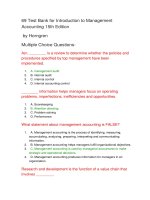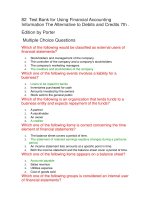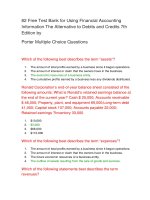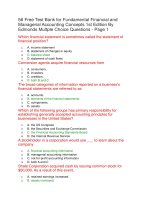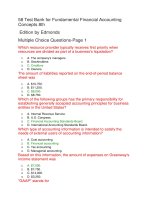answers test bank and soluton financial management
Bạn đang xem bản rút gọn của tài liệu. Xem và tải ngay bản đầy đủ của tài liệu tại đây (186.61 KB, 66 trang )
CHAPTER 2
The Recording Process
ASSIGNMENT CLASSIFICATION TABLE
Brief
Exercises
Learning Objectives
Questions
Do It!
1.
Explain what an account
is and how it helps in the
recording process.
1
2.
Define debits and credits
and explain their use in
recording business
transactions.
2, 3, 4, 5,
6, 7, 8, 9,
14, 21
1, 2, 5
3.
Identify the basic steps in
the recording process.
10, 19
4
4.
Explain what a journal is
and how it helps in the
recording process.
11, 12, 13,
14, 16
3, 6
5.
Explain what a ledger is
and how it helps in the
recording process.
17
6.
Explain what posting is
and how it helps in the
recording process.
15, 17
7, 8
3
7.
Prepare a trial balance
and explain its purposes.
18, 20
9, 10
4
A
Exercises Problems
B
Problems
1
1
2, 4, 6,
7, 14
1A, 2A,
3A, 5A
1B, 2B,
3B, 5B
1A, 2A,
3A, 5A
1B, 2B,
3B, 5B
9, 12
2A, 3A, 5A
2B, 3B, 5B
11, 13,
14, 15
2A, 3A,
4A, 5A
2B, 3B,
4B, 5B
6, 7
2
3, 5, 6, 7
10, 11, 12
8
Copyright © 2013 John Wiley & Sons, Inc. Weygandt Financial, IFRS, 2/e, Solution’s Manual (For Instructor Use Only)
2-1
ASSIGNMENT CHARACTERISTICS TABLE
Problem
Number
2-2
Description
Difficulty
Level
Time Allotted
(min.)
1A
Journalize a series of transactions.
Simple
20–30
2A
Journalize transactions, post, and prepare a trial balance.
Simple
30–40
3A
Journalize and post transactions and prepare a trial balance.
Moderate
40–50
4A
Prepare a correct trial balance.
Moderate
30–40
5A
Journalize transactions, post, and prepare a trial balance.
Moderate
40–50
1B
Journalize a series of transactions.
Simple
20–30
2B
Journalize transactions, post, and prepare a trial balance.
Simple
30–40
3B
Journalize transactions, post, and prepare a trial balance.
Moderate
40–50
4B
Prepare a correct trial balance.
Moderate
30–40
5B
Journalize transactions, post, and prepare a trial balance.
Moderate
40–50
Copyright © 2013 John Wiley & Sons, Inc. Weygandt Financial, IFRS, 2/e, Solution’s Manual (For Instructor Use Only)
WEYGANDT FINANCIAL ACCOUNTING, IFRS Version, 2e
CHAPTER 2
THE RECORDING PROCESS
Number
LO
BT
Difficulty
Time (min.)
BE1
2
C
Simple
6–8
BE2
2
C
Simple
4–6
BE3
4
AP
Simple
4–6
BE4
3
C
Moderate
4–6
BE5
2
C
Simple
6–8
BE6
4
AP
Simple
4–6
BE7
6
AP
Simple
4–6
BE8
6
AP
Simple
4–6
BE9
7
AP
Simple
4–6
BE10
7
AN
Moderate
6–8
DI1
2
C
Simple
3–5
DI2
4
AP
Simple
3–5
DI3
6
AP
Simple
2–4
DI4
7
AP
Simple
6–8
EX1
1
K
Simple
2–4
EX2
2
C
Simple
10–15
EX3
4
AP
Simple
8–10
EX4
2
C
Simple
6–8
EX5
4
AP
Simple
6–8
EX6
2–4
AP
Simple
6–8
EX7
2–4
AP
Simple
8–10
EX8
5
K
Simple
2–4
EX9
6, 7
AP
Simple
10–12
EX10
4, 7
AP
Moderate
10–12
EX11
4, 7
AP
Moderate
12–15
EX12
4, 6
AP
Moderate
12–15
EX13
7
AN
Moderate
6–8
EX14
2, 7
AP
Simple
8–10
EX15
7
C
Simple
4–6
Copyright © 2013 John Wiley & Sons, Inc. Weygandt Financial, IFRS, 2/e, Solution’s Manual (For Instructor Use Only)
2-3
THE RECORDING PROCESS (Continued)
Number
LO
BT
Difficulty
Time (min.)
P1A
2, 4
AP
Simple
20–30
P2A
2, 4, 6, 7
AP
Simple
30–40
P3A
2, 4, 6, 7
AP
Moderate
40–50
P4A
7
AN
Moderate
30–40
P5A
2, 4, 6, 7
AP
Moderate
40–50
P1B
2, 4
AP
Simple
20–30
P2B
2, 4, 6, 7
AP
Simple
30–40
P3B
2, 4, 6, 7
AP
Moderate
40–50
P4B
7
AN
Moderate
30–40
P5B
2, 4, 6, 7
AP
Moderate
40–50
BYP1
2
C
Simple
8–10
BYP2
2, 6
AN
Simple
8–10
BYP3
—
AP
Simple
15–20
BYP4
6, 7
AP, S
Moderate
20–30
BYP5
3, 6
S
Simple
10–15
BYP6
7
AN, E
Moderate
10–15
2-4
Copyright © 2013 John Wiley & Sons, Inc. Weygandt Financial, IFRS, 2/e, Solution’s Manual (For Instructor Use Only)
Learning Objective
Knowledge
Comprehension
Application
1.
Explain what an account
is and how it helps in the
recording process.
2.
Define debits and credits and Q2–21
explain their use in recording
business transactions.
Q2-2
Q2-3
Q2-4
Q2-5
Q2-6
3.
Identify the basic steps in
the recording process.
Q2-10
Q2-19
BE2-4
E2-6
E2-7
4.
Explain what a journal is and
how it helps in the recording
process.
Q2-12
Q2-11
Q2-13
Q2-14
Q2-16
BE2-3
BE2-6
DI2-2
E2-3
E2-5
E2-6
E2-7
E2-10
E2-11
E2-12
P2-1A
P2-2A
P2-3A
5.
Explain what a ledger is and
how it helps in the recording
process.
E2-8
Q2-17
6.
Explain what posting is and
how it helps in the recording
process.
Q2-15
Q2-17
BE2-7
BE2-8
DI2-3
E2-9
E2-12 P2-2B
P2-2A P2-3B
P2-3A P2-5B
P2-5A
7.
Prepare a trial balance and
explain its purposes.
Q2-18
E2-15
BE2-9
DI2-4
E2-9
E2-10
E2-11
E2-14
P2-2A
P2-3A
Broadening Your Perspective
Analysis
Synthesis
Evaluation
Q2-1
E2-1
Q2-7
Q2-8
Q2-9
Q2-14
BE2-1
BE2-2 E2-6
BE2-5 E2-7
DI2-1 E2-14
E2-2 P2-1A
E2-4 P2-2A
P2-3A P2-5B
P2-5A
P2-1B
P2-2B
P2-3B
P2-5A
P2-1B
P2-2B
P2-3B
P2-5B
P2-5A
P2-2B
P2-3B
P2-5B
Financial Reporting Decision–Making
Across the
Organization
Real–World Focus
Q2-20
BE2-10
E2-13
P2-4A
P2-4B
Comparative Analysis Communication Ethics Case
Ethics Case
Decision Making
Across the
Organization
BLOOM’S TAXONOMY TABLE
Copyright © 2013 John Wiley & Sons, Inc. Weygandt Financial, IFRS, 2/e, Solution’s Manual (For Instructor Use Only)
Correlation Chart between Bloom’s Taxonomy, Learning Objectives and End-of-Chapter Exercises and Problems
2-5
ANSWERS TO QUESTIONS
1.
A T-account has the following parts: (a) the title, (b) the left or debit side, and (c) the right or credit side.
2.
Disagree. The terms debit and credit mean left and right respectively.
3.
Jason is incorrect. The double-entry system merely records the dual effect of a transaction on the
accounting equation. A transaction is not recorded twice; it is recorded once, with a dual effect.
4.
Sandra is incorrect. A debit balance only means that debit amounts exceed credit amounts in an
account. Conversely, a credit balance only means that credit amounts are greater than debit
amounts in an account. Thus, a debit or credit balance is neither favorable nor unfavorable.
5.
(a) Asset accounts are increased by debits and decreased by credits.
(b) Liability accounts are decreased by debits and increased by credits.
(c) Revenues, Share Capital—Ordinary, and Retained Earnings are increased by credits and
decreased by debits. Expenses and Dividends are increased by debits and decreased by credits.
6.
(a)
(b)
(c)
(d)
(e)
(f)
(g)
Accounts Receivable—debit balance.
Cash—debit balance.
Dividends—debit balance.
Accounts Payable—credit balance.
Service Revenue—credit balance.
Salaries and Wages Expense—debit balance.
Share Capital—Ordinary—credit balance.
7.
(a)
(b)
(c)
(d)
(e)
Accounts Receivable—asset—debit balance.
Accounts Payable—liability—credit balance
Equipment—asset—debit balance.
Dividends—equity—debit balance.
Supplies—asset—debit balance.
8.
(a) Debit Supplies and credit Accounts Payable.
(b) Debit Cash and credit Notes Payable.
(c) Debit Salaries and Wages Expense and credit Cash.
9.
(1)
(2)
(3)
(4)
(5)
(6)
10.
2-6
Cash—both debit and credit entries.
Accounts Receivable—both debit and credit entries.
Dividends—debit entries only.
Accounts Payable—both debit and credit entries.
Salaries and Wages Expense—debit entries only.
Service Revenue—credit entries only.
The basic steps in the recording process are:
1. Analyze each transaction for its effect on the accounts.
2. Enter the transaction information in a journal.
3. Transfer the journal information to the appropriate accounts in the ledger.
Copyright © 2013 John Wiley & Sons, Inc. Weygandt Financial, IFRS, 2/e, Solution’s Manual (For Instructor Use Only)
Questions Chapter 2 (Continued)
11.
The advantages of using a journal in the recording process are:
(a) It discloses in one place the complete effects of a transaction.
(b) It provides a chronological record of transactions.
(c) It helps to prevent or locate errors because the debit and credit amounts for each entry can be
easily compared.
12.
(a) The debit should be entered first.
(b) The credit should be indented.
13.
When three or more accounts are required in one journal entry, the entry is referred to as a
compound entry. An example of a compound entry is the purchase of equipment, part of which is
paid in cash and the remainder is on account.
14.
(a) No, business transaction debits and credits should not be recorded directly in the ledger.
(b) The advantages of using a journal are:
1. It discloses in one place the complete effects of a transaction.
2. It provides a chronological record of transactions.
3. It helps to prevent or locate errors because the debit and credit amounts for each entry can
be easily compared.
15.
The advantage of the last step in the posting process is to indicate that the item has been posted.
16.
(a) Cash ..............................................................................................
Share Capital—Ordinary .......................................................
(Issued ordinary shares for cash)
9,000
(b) Prepaid Insurance .........................................................................
Cash .....................................................................................
(Paid one-year insurance policy)
800
(c)
17.
9,000
800
Supplies.........................................................................................
Accounts Payable .................................................................
(Purchased supplies on account)
2,000
(d) Cash ..............................................................................................
Service Revenue ..................................................................
(Received cash for services rendered)
7,500
2,000
7,500
(a) The entire group of accounts maintained by a company, including all the asset, liability, and
equity accounts, is referred to collectively as the ledger.
(b) A chart of accounts is a list of accounts and the account numbers that identify their location in the
ledger. The chart of accounts is important, particularly for a company that has a large number of
accounts, because it helps organize the accounts and define the level of detail that a company
desires in its accounting system.
Copyright © 2013 John Wiley & Sons, Inc. Weygandt Financial, IFRS, 2/e, Solution’s Manual (For Instructor Use Only)
2-7
Questions Chapter 2 (Continued)
18.
A trial balance is a list of accounts and their balances at a given time. The primary purpose of a trial
balance is to prove (check) that the debits equal the credits after posting. A trial balance also
facilitates the discovery of errors in journalizing and posting. In addition, it is useful in preparing
financial statements.
19.
No, Joe is not correct. The proper sequence is as follows:
(b) Business transaction occurs.
(c) Information entered in the journal.
(a) Debits and credits posted to the ledger.
(e) Trial balance is prepared.
(d) Financial statements are prepared.
20.
(a) The trial balance would balance.
(b) The trial balance would not balance.
21.
The normal balances are Cash-debit, Accounts Payable-credit, and Interest Expense-debit.
2-8
Copyright © 2013 John Wiley & Sons, Inc. Weygandt Financial, IFRS, 2/e, Solution’s Manual (For Instructor Use Only)
SOLUTIONS TO BRIEF EXERCISES
BRIEF EXERCISE 2-1
1.
2.
3.
4.
5.
6.
Accounts Payable
Advertising Expense
Service Revenue
Accounts Receivable
Share Capital—Ordinary
Dividends
(a)
Debit
Effect
Decrease
Increase
Decrease
Increase
Decrease
Increase
(c)
Normal
Balance
Credit
Debit
Credit
Debit
Credit
Debit
(b)
Credit
Effect
Increase
Decrease
Increase
Decrease
Increase
Decrease
BRIEF EXERCISE 2-2
June 1
2
3
12
Account Debited
Cash
Equipment
Rent Expense
Accounts Receivable
Account Credited
Share Capital—Ordinary
Accounts Payable
Cash
Service Revenue
BRIEF EXERCISE 2-3
June 1
2
3
12
Cash ......................................................................
Share Capital—Ordinary .............................
4,000
Equipment ............................................................
Accounts Payable ........................................
900
Rent Expense .......................................................
Cash ..............................................................
800
Accounts Receivable ..........................................
Service Revenue ..........................................
300
4,000
900
800
Copyright © 2013 John Wiley & Sons, Inc. Weygandt Financial, IFRS, 2/e, Solution’s Manual (For Instructor Use Only)
300
2-9
BRIEF EXERCISE 2-4
The basic steps in the recording process are:
1.
Analyze each transaction. In this step, business documents are examined to
determine the effects of the transaction on the accounts.
2.
Enter each transaction in a journal. This step is called journalizing and it
results in making a chronological record of the transactions.
3.
Transfer journal information to ledger accounts. This step is called
posting. Posting makes it possible to accumulate the effects of
journalized transactions on individual accounts.
BRIEF EXERCISE 2-5
(a)
Aug.
2-10
Effect on Accounting Equation
(b)
Debit-Credit Analysis
1 The asset Cash is increased; the
equity account Share Capital—
Ordinary is increased.
Debits increase assets:
debit Cash R$5,000.
Credits increase equity: credit Share
Capital—Ordinary R$5,000.
4 The asset Prepaid Insurance is
increased; the asset Cash is
decreased.
Debits increase assets:
debit Prepaid Insurance R$1,800.
Credits decrease assets:
credit Cash R$1,800.
16 The asset Cash is increased; the
revenue Service Revenue is
increased.
Debits increase assets:
debit Cash R$1,100.
Credits increase revenues:
credit Service Revenue R$1,100.
27 The expense Salaries and Wages
Expense is increased; the asset
Cash is decreased.
Debits increase expenses:
debit Salaries and Wages Expense
R$1,000.
Credits decrease assets:
credit Cash R$1,000.
Copyright © 2013 John Wiley & Sons, Inc. Weygandt Financial, IFRS, 2/e, Solution’s Manual (For Instructor Use Only)
BRIEF EXERCISE 2-6
Aug. 1
4
16
27
Cash ......................................................................
Share Capital—Ordinary ..............................
5,000
Prepaid Insurance ................................................
Cash ...............................................................
1,800
Cash ......................................................................
Service Revenue ...........................................
1,100
Salaries and Wages Expense ..............................
Cash ...............................................................
1,000
5,000
1,800
1,100
1,000
BRIEF EXERCISE 2-7
Cash
5/12
2,100
5/15
3,000
Ending Bal. 5,100
5/5
Accounts Receivable
5,000 5/12
Service Revenue
5/5
5,000
5/15
3,000
Ending Bal. 8,000
2,100
Ending Bal. 2,900
BRIEF EXERCISE 2-8
Cash
Date
May 12
15
Explanation
Ref.
J1
J1
Debit
2,100
3,000
Credit
Copyright © 2013 John Wiley & Sons, Inc. Weygandt Financial, IFRS, 2/e, Solution’s Manual (For Instructor Use Only)
Balance
2,100
5,100
2-11
BRIEF EXERCISE 2-8 (Continued)
Accounts Receivable
Date
Explanation
May 5
12
Ref.
J1
J1
Debit
5,000
Service Revenue
Date
Explanation
May 5
15
Ref.
J1
J1
Debit
Credit
2,100
Balance
5,000
2,900
Credit
5,000
3,000
Balance
5,000
8,000
BRIEF EXERCISE 2-9
STARR COMPANY
Trial Balance
June 30, 2014
Cash .............................................................................
Accounts Receivable ..................................................
Equipment ...................................................................
Accounts Payable .......................................................
Share Capital—Ordinary .............................................
Dividends .....................................................................
Service Revenue .........................................................
Salaries and Wages Expense ....................................
Rent Expense ..............................................................
2-12
Debit
$ 6,800
3,000
17,000
Credit
$ 9,000
20,000
1,200
6,000
6,000
1,000
$35,000
$35,000
Copyright © 2013 John Wiley & Sons, Inc. Weygandt Financial, IFRS, 2/e, Solution’s Manual (For Instructor Use Only)
BRIEF EXERCISE 2-10
CHENG COMPANY
Trial Balance
December 31, 2014
Cash .............................................................................
Prepaid Insurance .......................................................
Accounts Payable .......................................................
Unearned Service Revenue ........................................
Share Capital—Ordinary .............................................
Dividends .....................................................................
Service Revenue .........................................................
Salaries and Wages Expense.....................................
Rent Expense ..............................................................
Debit
£16,800
3,500
Credit
£ 3,000
4,200
13,000
4,500
25,600
18,600
2,400
£45,800
£45,800
SOLUTIONS FOR DO IT! REVIEW EXERCISES
DO IT! 2-1
Graham would likely need the following accounts in which to record the
transactions necessary to ready his photography studio for opening day:
Cash (debit balance)
Supplies
(debit balance)
Equipment
(debit balance)
Notes Payable (credit balance)
Accounts Payable
(credit balance)
Share Capital—Ordinary (credit balance)
Rent Expense (debit balance)
DO IT! 2-2
Each transaction that is recorded is entered in the general journal. The three
activities would be recorded as follows:
1.
2.
3.
Cash ..............................................................
Share Capital—Ordinary .....................
8,000
Supplies ........................................................
Cash .....................................................
Accounts Payable ...............................
1,600
8,000
400
1,200
No entry because no transaction has occurred.
Copyright © 2013 John Wiley & Sons, Inc. Weygandt Financial, IFRS, 2/e, Solution’s Manual (For Instructor Use Only)
2-13
DO IT! 2-3
Cash
4/1 1,600 4/16 600
4/3 3,700 4/20 500
4/30 4,200
DO IT! 2-4
CHILLIN’ COMPANY
Trial Balance
December 31, 2014
Debit
Cash ............................................................................. R$ 6,000
Accounts Receivable ..................................................
8,000
Supplies .......................................................................
5,000
Equipment ...................................................................
76,000
Notes Payable .............................................................
Accounts Payable .......................................................
Salaries and Wages Payable......................................
Share Capital—Ordinary .............................................
Dividends .....................................................................
8,000
Service Revenue .........................................................
Rent Expense ..............................................................
2,000
Salaries and Wages Expense ....................................
38,000
R$143,000
2-14
Credit
R$ 20,000
9,000
3,000
25,000
86,000
R$143,000
Copyright © 2013 John Wiley & Sons, Inc. Weygandt Financial, IFRS, 2/e, Solution’s Manual (For Instructor Use Only)
SOLUTIONS TO EXERCISES
EXERCISE 2-1
1.
False. An account is an accounting record of a specific asset, liability, or
equity item.
2.
False. An account shows increases and decreases in the item it relates to.
3.
False. Each asset, liability, and equity item has a separate account.
4.
False. An account has a left, or debit side, and a right, or credit side.
5.
True.
Copyright © 2013 John Wiley & Sons, Inc. Weygandt Financial, IFRS, 2/e, Solution’s Manual (For Instructor Use Only)
2-15
Copyright © 2013 John Wiley & Sons, Inc. Weygandt Financial, IFRS, 2/e, Solution’s Manual (For Instructor Use Only)
Effect
(d)
Normal
Balance
Share
Capital—
Ordinary
Increase
Credit
Asset
Cash
Decrease
Debit
Debit
Liability
Accounts
Payable
Increase
Credit
Increase
Debit
Equity
Service
Revenue
Increase
Credit
Advertising
Expense
Increase
Debit
Asset
Cash
Decrease
Debit
Asset
Cash
Increase
Debit
Asset
Accounts
Receivable
Decrease
Debit
23
Liability
Accounts
Payable
Decrease
Credit
Asset
Cash
Decrease
Debit
28
Equity
Dividends
Increase
Debit
Asset
Cash
Decrease
Debit
Effect
(d)
Normal
Balance
(a)
Basic
Type
(b)
Specific
Account
Cash
Increase
Debit
Equity
Asset
Equipment
Increase
Debit
9
Asset
Supplies
Increase
11
Asset
Accounts
Receivable
16
Equity
20
(a)
Basic
Type
(b)
Specific
Account
2
Asset
3
Date
Jan.
Account Credited
(c)
(c)
EXERCISE 2-2
2-16
Account Debited
EXERCISE 2-3
General Journal
Account Titles and Explanation
Date
Jan. 2
3
9
11
16
20
23
28
Ref.
Debit
Cash ...................................................
Share Capital—Ordinary...........
15,000
Equipment .........................................
Cash ...........................................
7,000
Supplies.............................................
Accounts Payable .....................
500
Accounts Receivable .......................
Service Revenue .......................
1,800
Advertising Expense ........................
Cash ...........................................
200
Cash ...................................................
Accounts Receivable................
700
Accounts Payable.............................
Cash ...........................................
300
Dividends ..........................................
Cash ...........................................
1,000
J1
Credit
15,000
7,000
500
1,800
200
700
300
1,000
EXERCISE 2-4
Oct. 1
Debits increase assets: debit Cash ¥200,000.
Credits increase equity: credit Share Capital—Ordinary ¥200,000.
2
No transaction.
3
Debits increase assets: debit Equipment ¥19,000.
Credits increase liabilities: credit Accounts Payable ¥19,000.
Copyright © 2013 John Wiley & Sons, Inc. Weygandt Financial, IFRS, 2/e, Solution’s Manual (For Instructor Use Only)
2-17
EXERCISE 2-4 (Continued)
Oct. 6
Debits increase assets: debit Accounts Receivable ¥32,000.
Credits increase revenues: credit Service Revenue ¥32,000.
27
Debits decrease liabilities: debit Accounts Payable ¥8,500.
Credits decrease assets: credit Cash ¥8,500.
30
Debits increase expenses: debit Salaries and Wages Expense
¥25,000.
Credits decrease assets: credit Cash ¥25,000.
EXERCISE 2-5
Date
Oct. 1
Debit
200,000
No entry.
3
Equipment .........................................
Accounts Payable ....................
19,000
Accounts Receivable ........................
Service Revenue .......................
32,000
Accounts Payable .............................
Cash...........................................
8,500
Salaries and Wages Expense ...........
Cash...........................................
25,000
27
30
Credit
200,000
2
6
2-18
General Journal
Account Titles
Ref.
Cash....................................................
Share Capital—Ordinary ..........
19,000
32,000
8,500
25,000
Copyright © 2013 John Wiley & Sons, Inc. Weygandt Financial, IFRS, 2/e, Solution’s Manual (For Instructor Use Only)
EXERCISE 2-6
(a)
1.
2.
3.
Increase the asset Cash, increase the liability Notes Payable.
Increase the asset Equipment, decrease the asset Cash.
Increase the asset Supplies, increase the liability Accounts Payable.
(b)
1.
Cash ..................................................................
Notes Payable ...........................................
Equipment .......................................................
Cash ...........................................................
Supplies ............................................................
Accounts Payable .....................................
2.
3.
50,000
50,000
25,000
25,000
4,500
4,500
EXERCISE 2-7
(a)
(b)
Assets = Liabilities + Equity
1. +
+
2. –
–
3. +
+
4. –
–
1.
2.
3.
4.
(Issued shares)
(Expense)
(Revenue)
(Dividends)
Cash ..................................................................
Share Capital—Ordinary ...........................
Rent Expense ...................................................
Cash ...........................................................
Accounts Receivable .......................................
Service Revenue .......................................
Dividends ..........................................................
Cash ...........................................................
5,000
5,000
1,100
1,100
4,700
4,700
700
700
EXERCISE 2-8
1.
2.
3.
4.
5.
False. The general ledger contains all the asset, liability, and equity
accounts.
True.
False. The accounts in the general ledger are arranged in financial
statement order: first the assets, then the liabilities, share capital,
retained earnings, dividends, revenues, and expenses.
True.
False. The general ledger is not a book of original entry; transactions
are first recorded in the general journal, then in the general ledger.
Copyright © 2013 John Wiley & Sons, Inc. Weygandt Financial, IFRS, 2/e, Solution’s Manual (For Instructor Use Only)
2-19
EXERCISE 2-9
(a)
Aug. 1
10
31
Bal.
Cash
5,000 Aug. 12
2,700
850
7,550
Accounts Receivable
Aug. 25
1,600 Aug. 31
Bal.
750
Aug. 12
(b)
Equipment
5,000
1,000
Notes Payable
Aug. 12
Share Capital—Ordinary
Aug. 1
5,000
850
Service Revenue
Aug. 10
25
Bal.
2,700
1,600
4,300
ROBERTA MENDEZ, INVESTMENT BROKER
Trial Balance
August 31, 2014
Cash .........................................................................
Accounts Receivable ..............................................
Equipment ................................................................
Notes Payable ..........................................................
Share Capital—Ordinary .........................................
Service Revenue .....................................................
Debit
$ 7,550
750
5,000
$13,300
2-20
4,000
Credit
$ 4,000
5,000
4,300
$13,300
Copyright © 2013 John Wiley & Sons, Inc. Weygandt Financial, IFRS, 2/e, Solution’s Manual (For Instructor Use Only)
EXERCISE 2-10
(a)
Date
Apr. 1
12
15
25
29
30
General Journal
Account Titles and Explanation
Ref.
Cash ..................................................... 101
Share Capital—Ordinary ................. 311
(Issued shares for cash)
Debit
10,000
Credit
10,000
Cash .....................................................
Service Revenue .............................
(Received cash for
services provided)
101
400
900
Salaries and Wages Expense.............
Cash .................................................
(Paid salaries to date)
726
101
720
Accounts Payable ...............................
Cash .................................................
(Paid creditors on account)
201
101
1,500
Cash .....................................................
Accounts Receivable......................
(Received cash in payment
of account)
101
112
400
Cash .....................................................
Unearned Service Revenue ...........
(Received cash for future
services)
101
209
1,000
900
720
1,500
400
Copyright © 2013 John Wiley & Sons, Inc. Weygandt Financial, IFRS, 2/e, Solution’s Manual (For Instructor Use Only)
1,000
2-21
EXERCISE 2-10 (Continued)
(b)
PADRE LANDSCAPING COMPANY
Trial Balance
April 30, 2014
Cash ..........................................................................
Accounts Receivable ...............................................
Supplies ....................................................................
Accounts Payable ....................................................
Unearned Service Revenue .....................................
Share Capital—Ordinary ..........................................
Service Revenue ......................................................
Salaries and Wages Expense ..................................
Credit
Debit
$10,080
2,800
1,800
$
300
1,000
10,000
4,100
720
$15,400
$15,400
EXERCISE 2-11
(a) Oct. 1 Cash .............................................................
Share Capital—Ordinary ......................
(Issued shares for cash)
5,000
10 Cash .............................................................
Service Revenue ..................................
(Received cash for services
provided)
650
10 Cash .............................................................
Notes Payable .......................................
(Obtained loan from bank)
3,000
20 Cash .............................................................
Accounts Receivable ...........................
(Received cash in payment of
account)
500
20 Accounts Receivable ..................................
Service Revenue ..................................
(Billed clients for services
provided)
940
2-22
5,000
650
3,000
500
940
Copyright © 2013 John Wiley & Sons, Inc. Weygandt Financial, IFRS, 2/e, Solution’s Manual (For Instructor Use Only)
EXERCISE 2-11 (Continued)
(b)
SPARKS CO.
Trial Balance
October 31, 2014
Cash......................................................................
Accounts Receivable ..........................................
Supplies ...............................................................
Equipment ...........................................................
Notes Payable ......................................................
Accounts Payable ...............................................
Share Capital—Ordinary .....................................
Dividends .............................................................
Service Revenue ..................................................
Salaries and Wages Expense .............................
Rent Expense ......................................................
Debit
$ 8,170
1,240
400
2,000
Credit
$ 3,000
500
7,000
300
2,390
500
280
$12,890
$12,890
EXERCISE 2-12
(a)
Date
Sept. 1
5
25
30
General Journal
Account Titles
Cash...................................................
Share Capital—Ordinary...........
Ref.
101
311
Debit
10,000
Equipment .........................................
Cash ...........................................
Accounts Payable.....................
157
101
201
12,000
Accounts Payable ............................
Cash ...........................................
201
101
2,400
Dividends ..........................................
Cash ...........................................
332
101
500
J1
Credit
10,000
4,000
8,000
2,400
Copyright © 2013 John Wiley & Sons, Inc. Weygandt Financial, IFRS, 2/e, Solution’s Manual (For Instructor Use Only)
500
2-23
EXERCISE 2-12 (Continued)
(b)
Cash
Date
Sept. 1
5
25
30
Explanation
Equipment
Date
Explanation
Sept. 5
Accounts Payable
Date
Explanation
Sept. 5
25
Share Capital—Ordinary
Date
Explanation
Sept. 1
Dividends
Date
Explanation
Sept. 30
2-24
Ref.
J1
J1
J1
J1
Ref.
J1
Ref.
J1
J1
Ref.
J1
Ref.
J1
Debit
10,000
Credit
4,000
2,400
500
Debit
12,000
Debit
Credit
No. 157
Balance
12,000
Credit
8,000
No. 201
Balance
8,000
5,600
2,400
Debit
Debit
500
No. 101
Balance
10,000
6,000
3,600
3,100
Credit
10,000
Credit
No. 311
Balance
10,000
No. 332
Balance
500
Copyright © 2013 John Wiley & Sons, Inc. Weygandt Financial, IFRS, 2/e, Solution’s Manual (For Instructor Use Only)
EXERCISE 2-13
Error
1.
2.
3.
4.
5.
6.
(a)
In Balance
No
Yes
Yes
No
Yes
No
(b)
Difference
$400
—
—
300
—
36
(c)
Larger Column
Debit
—
—
Credit
—
Credit
EXERCISE 2-14
TEMPUS FUGIT DELIVERY SERVICE
Trial Balance
July 31, 2014
Debit
Cash (£90,907 – Debit total without Cash
£69,340) ....................................................................
Accounts Receivable ..................................................
Prepaid Insurance .......................................................
Equipment....................................................................
Notes Payable..............................................................
Accounts Payable .......................................................
Salaries and Wages Payable ......................................
Share Capital—Ordinary .............................................
Retained Earnings.......................................................
Dividends .....................................................................
Service Revenue .........................................................
Salaries and Wages Expense.....................................
Maintenance and Repairs Expense ...........................
Gasoline Expense .......................................................
Utilities Expense .........................................................
Credit
£21,567
10,642
1,968
49,360
£26,450
8,396
815
40,000
4,636
700
10,610
4,428
961
758
523
£90,907
£90,907
EXERCISE 2-15
Transactions 4, 5, and 7 are operating activities
Transaction 3 is an investing activity
Transactions 1, 2 and 6 are financing activities.
Copyright © 2013 John Wiley & Sons, Inc. Weygandt Financial, IFRS, 2/e, Solution’s Manual (For Instructor Use Only)
2-25



